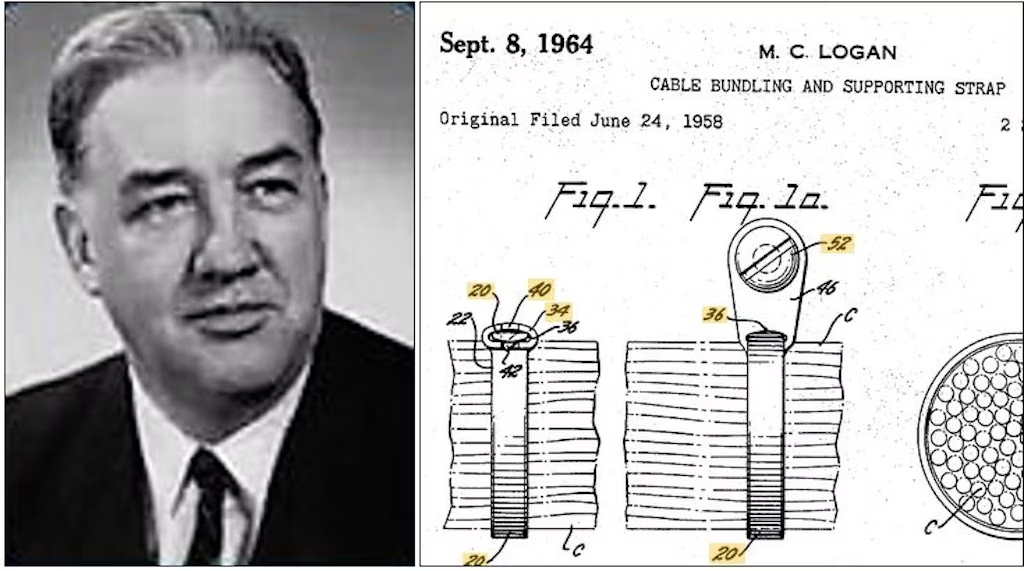Οι δεσμοί καλωδίων, που εφευρέθηκαν το 1958 από τον Maurus C. Logan στην Thomas & Betts, έφεραν επανάσταση στη διαχείριση των καλωδίων σε διάφορες βιομηχανίες, οδηγώντας στην ανάπτυξη εξειδικευμένων εργαλείων, όπως τα πιστόλια δεσμών καλωδίων για αποτελεσματική και ασφαλή εφαρμογή.
Η εφεύρεση του Maurus C. Logan

Το 1956, ο Maurus C. Logan, μηχανικός της Thomas & Betts, εμπνεύστηκε την ιδέα να δημιουργήσει μια πιο αποτελεσματική λύση διαχείρισης καλωδίων μετά την επίσκεψή του σε εγκαταστάσεις αεροσκαφών της Boeing. Βλέποντας τους εργαζόμενους να παλεύουν με τα νάιλον καλώδια με επικάλυψη κεριού και να υφίστανται τραυματισμούς, ο Logan ξεκίνησε να αναπτύξει μια καλύτερη εναλλακτική λύση. Η εφεύρεσή του, ο δετήρας καλωδίων Ty-Rap, κατοχυρώθηκε με δίπλωμα ευρεσιτεχνίας στις 24 Ιουνίου 1958. Αυτός ο καινοτόμος σχεδιασμός διέθετε ένα μεταλλικό δόντι και σχεδιάστηκε ειδικά για να συγκρατεί με ασφάλεια τις καλωδιώσεις των αεροπλάνων, εξαλείφοντας την ανάγκη για περίπλοκους κόμπους και βελτιώνοντας τόσο την ασφάλεια όσο και την αποτελεσματικότητα στην αεροδιαστημική βιομηχανία.
Εξερευνήστε περισσότερα : wikipedia
Εξέλιξη των δεσμών καλωδίων
Μετά την αρχική εφεύρεση, οι καλωδιοδέτες εξελίχθηκαν σημαντικά κατά την επόμενη δεκαετία. Ο αρχικός σχεδιασμός με τα μεταλλικά δόντια μετατράπηκε σε πιο ευέλικτα νάιλον και πλαστικά υλικά, επεκτείνοντας τις εφαρμογές τους πέρα από την αεροδιαστημική σε βιομηχανίες όπως οι τηλεπικοινωνίες και η αυτοκινητοβιομηχανία. Αυτή η εξέλιξη των υλικών και του σχεδιασμού κατέστησε τους καλωδιοδέτες πιο προσαρμόσιμους και οικονομικά αποδοτικούς για ένα ευρύτερο φάσμα χρήσεων. Η μάρκα Ty-Rap, που καθιερώθηκε από την Thomas & Betts, έγινε συνώνυμη με τους δεσμούς καλωδίων και έπαιξε καθοριστικό ρόλο στην ευρεία υιοθέτησή τους. Καθώς η τεχνολογία βελτιωνόταν, οι κατασκευαστές επικεντρώθηκαν στη δημιουργία δεσμών που ήταν όχι μόνο ισχυρότεροι και ανθεκτικότεροι αλλά και ευκολότεροι στην τοποθέτηση και την αφαίρεση, ανοίγοντας το δρόμο για την ανάπτυξη εξειδικευμένων εργαλείων, όπως τα πιστόλια δεσίματος καλωδίων.

VIOX Πιστόλι δεσίματος καλωδίων
Σκοπός των όπλων δεσίματος καλωδίων
Τα πιστόλια καλωδιακής σύνδεσης εμφανίστηκαν ως μια λύση για τον εξορθολογισμό της διαδικασίας εφαρμογής και την αντιμετώπιση των προβλημάτων ασφαλείας που σχετίζονται με τη χειροκίνητη εγκατάσταση καλωδιακής σύνδεσης. Αυτά τα εξειδικευμένα εργαλεία εξασφαλίζουν σταθερή τάση κατά την εφαρμογή των δεσμών, μειώνοντας τον κίνδυνο τραυματισμών από επαναλαμβανόμενη καταπόνηση που μπορεί να αντιμετωπίσουν οι εργαζόμενοι όταν σφίγγουν τους δεσμούς με το χέρι. Τα πιστόλια δεσίματος καλωδίων παρέχουν επίσης ένα καθαρό φινίρισμα με την αυτόματη περικοπή του πλεονάζοντος υλικού, εξαλείφοντας τις αιχμηρές άκρες που θα μπορούσαν να αποτελέσουν κίνδυνο για την ασφάλεια. Διαθέσιμα τόσο σε χειροκίνητες όσο και σε μηχανοκίνητες εκδόσεις (πνευματικές ή ηλεκτρικές), τα εργαλεία αυτά έχουν γίνει απαραίτητα σε βιομηχανίες που απαιτούν εκτεταμένη διαχείριση καλωδίων, προσφέροντας βελτιωμένη αποτελεσματικότητα και ασφάλεια στην ασφάλιση δεσμών καλωδίων.
Τύποι όπλων δεσίματος καλωδίων
Τα πιστόλια δεσίματος καλωδίων διατίθενται σε διάφορους τύπους για να ταιριάζουν σε διαφορετικές εφαρμογές και προτιμήσεις χρηστών:
- Τα χειροκίνητα πιστόλια λειτουργούν με μηχανισμούς που κινούνται με το χέρι, ιδανικά για περιστασιακή χρήση ή μικρότερα έργα.
- Οι ηλεκτροκίνητες εκδόσεις περιλαμβάνουν πνευματικά και ηλεκτρικά μοντέλα, σχεδιασμένα για εφαρμογές μεγάλου όγκου και βιομηχανικές ρυθμίσεις.
- Τα πιστόλια που ελέγχονται από την τάση επιτρέπουν στους χρήστες να ρυθμίζουν συγκεκριμένα επίπεδα τάσης, εξασφαλίζοντας σταθερή σφικτότητα σε πολλαπλούς δεσμούς.
- Τα αυτόματα πιστόλια μπορούν να τροφοδοτούν, να σφίγγουν και να κόβουν δεσμούς με ταχεία διαδοχή, αυξάνοντας σημαντικά την αποδοτικότητα σε εργασίες μεγάλης κλίμακας.
Αυτά τα εργαλεία έχουν γίνει απαραίτητα σε βιομηχανίες που απαιτούν εκτεταμένη διαχείριση καλωδίων, προσφέροντας βελτιωμένη ταχύτητα, συνέπεια και εργονομία σε σύγκριση με τις χειροκίνητες μεθόδους εφαρμογής δεσμών.


